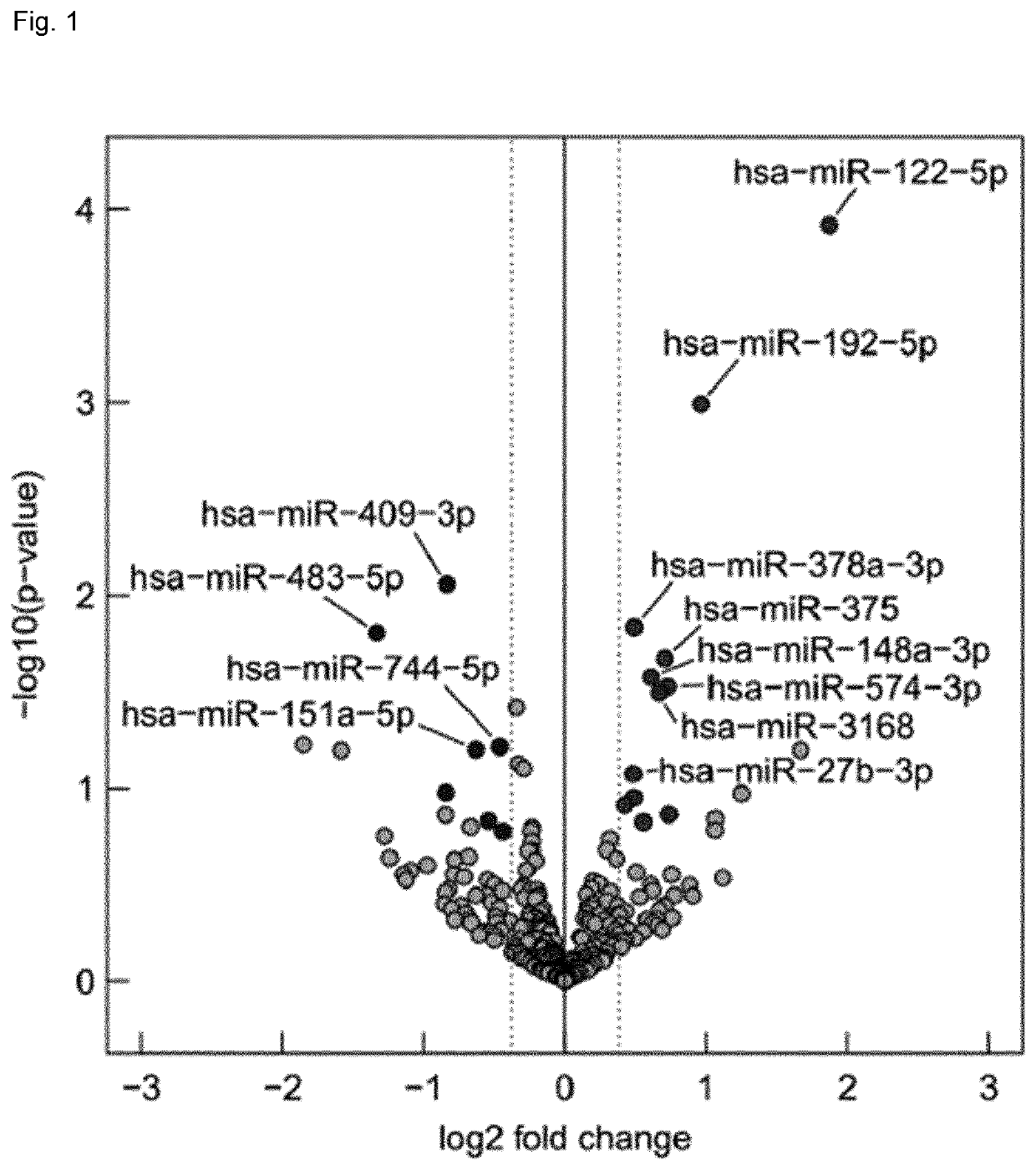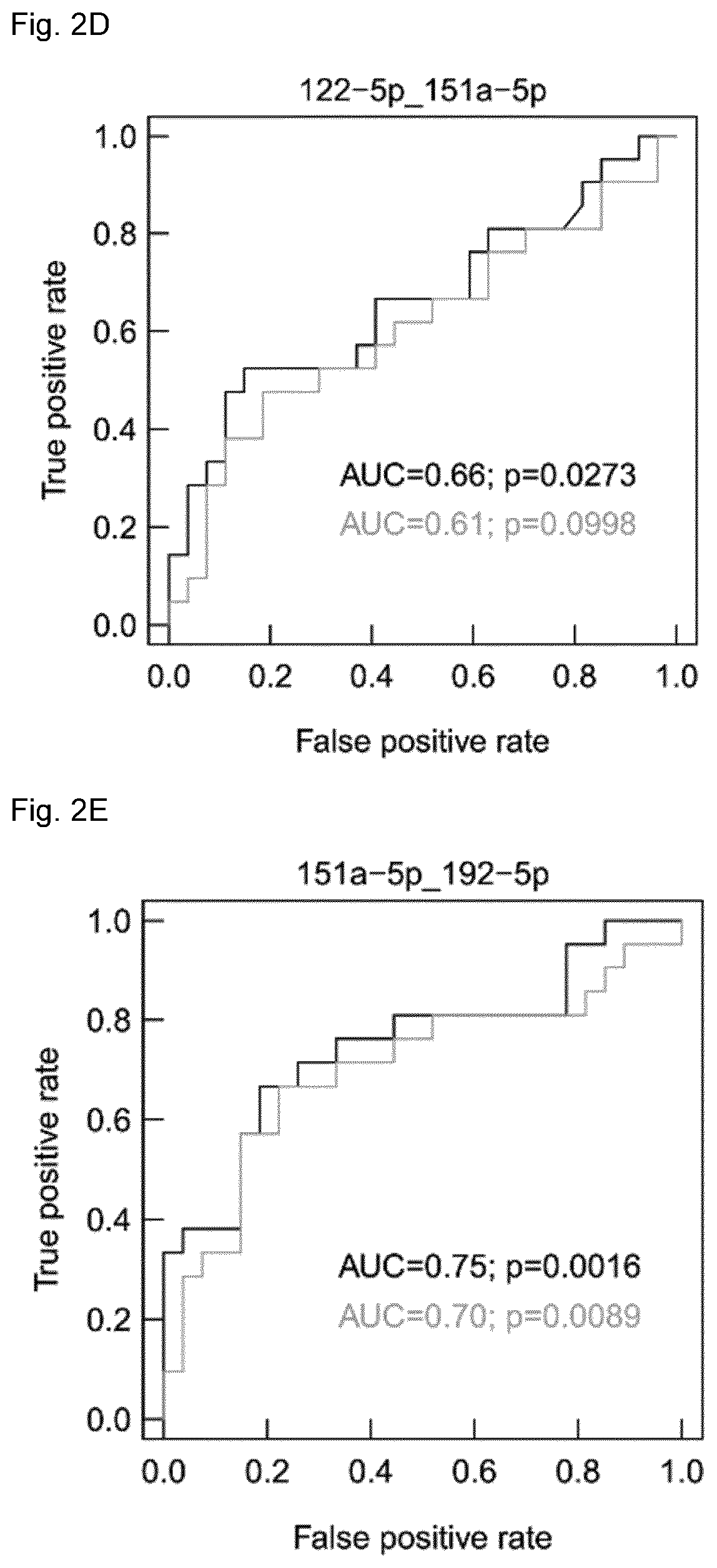Micro-RNA signatures for the prediction of liver dysfunction
a microrna signature and liver technology, applied in the direction of microbiological testing/measurement, biochemistry apparatus and processes, etc., can solve the problems of limited treatment options for patients with postoperative ld, limited treatment options, and limited reliable predictive markers for determining patients at risk of developing ld, in particular after surgery
- Summary
- Abstract
- Description
- Claims
- Application Information
AI Technical Summary
Benefits of technology
Problems solved by technology
Method used
Image
Examples
example 1
ing the Predictive miRNA Panel for Liver Dysfunction Post-Surgery in the Discovery Cohort
[0208]A total of 48 patients with either mCRC, HCC or CCC who underwent liver resection between February 2012 and April 2016 were included in our discovery cohort. To achieve a representative cohort, 21 patients suffering from postoperative LD were matched based on basic characteristics, liver function and extend of liver resection to 27 patients without postoperative LD. Subsequently, additional 24 patients served as a prospective, clinically relevant validation cohort. Patient characteristics are shown in Table 2 and were compared between the discovery and the validation cohort. Of note, given the selection of the discovery cohort, there was a significantly higher number of patients undergoing major liver resection in the discovery cohort, which was paralleled by significantly worse ICG-clearance and gamma-glutamyl transpeptidase values.
[0209]
TABLE 2Patient DemographicsEntire CohortEvaluationV...
example 2
n of the Discovered miRNA Ratios in an Independent Validation Cohort
[0213]To confirm the clinical utility of the identified miRNA ratios, the predictive performance of the 2 miRNA pairs was validated in an independent prospective validation cohort consisting of 24 patients, 19 without and 5 with postoperative LD, reflecting the natural incidence of 30% post-surgical LD. As depicted in FIG. 3A for the miRNA pair 122-5p / 151a-5p and FIG. 3B for the miRNA pair 151a-5p / 192-5p there was a strong trend towards differentially regulated miRNAs in patients with LD compared to controls already within this small sample size. The diagnostic performance of a multivariate model as measured by ROC analysis showed an excellent AUC of 0.80 for the 2 miRNA pairs (FIG. 3C). Further, it was validated that the two cut-offs were able to predict postoperative LD for cut-off P>0.59 with p=0.018 (FIG. 3D) and for cut-off P>0.68 with p=0.036 (FIG. 3E), respectively.
example 3
n of the Discovered miRNA Ratios to Other Predictors for Postoperative LD
[0214]Next, the performance of the miRNA based prediction model was evaluated in the combined dataset (N=72). Therefore, the diagnostic performance of the two cut-offs were illustrated using sensitivity (SN), specificity (SP), positive predictive value (PPV), negative predictive value (NPV) and the odd's ratio (OR). The low stringency cut-off (>0.59) yielded balanced PPV and NPV values (0.80 and 0.81, respectively, while the stringent cut-off (>0.68) resulted in a PPV of 1.0, with an acceptable NPV of 0.74 (FIG. 4A), indicating that all patients tested positive suffered from post-operative LD, while 74% of patients tested negative did not suffer from post-operative LD. Vice-versa, 26% of patients tested negative did in fact suffer from post-operative LD. The ORs for an adverse event were 15.92 (p<0.0001) and infinite (p<0.0001), respectively. Receiver operator characteristics (ROC) curve analysis was performed ...
PUM
| Property | Measurement | Unit |
|---|---|---|
| body weight | aaaaa | aaaaa |
| concentration | aaaaa | aaaaa |
| size | aaaaa | aaaaa |
Abstract
Description
Claims
Application Information
 Login to View More
Login to View More - R&D
- Intellectual Property
- Life Sciences
- Materials
- Tech Scout
- Unparalleled Data Quality
- Higher Quality Content
- 60% Fewer Hallucinations
Browse by: Latest US Patents, China's latest patents, Technical Efficacy Thesaurus, Application Domain, Technology Topic, Popular Technical Reports.
© 2025 PatSnap. All rights reserved.Legal|Privacy policy|Modern Slavery Act Transparency Statement|Sitemap|About US| Contact US: help@patsnap.com



